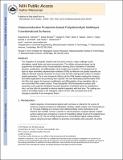| dc.contributor.author | Samuel, Raymond E. | |
| dc.contributor.author | Paik, Daniel H. | |
| dc.contributor.author | Fang, Jean C. | |
| dc.contributor.author | Schmidt, Daniel J. | |
| dc.contributor.author | Shukla, A. | |
| dc.contributor.author | Wang, Mary | |
| dc.contributor.author | Hammond, Paula T | |
| dc.date.accessioned | 2015-10-21T15:24:11Z | |
| dc.date.available | 2015-10-21T15:24:11Z | |
| dc.date.issued | 2011-07 | |
| dc.date.submitted | 2011-05 | |
| dc.identifier.issn | 01429612 | |
| dc.identifier.issn | 1878-5905 | |
| dc.identifier.uri | http://hdl.handle.net/1721.1/99389 | |
| dc.description.abstract | The integration of orthopedic implants with host bone presents a major challenge in joint arthroplasty, spinal fusion and tumor reconstruction. The cellular microenvironment can be programmed via implant surface functionalization allowing direct modulation of osteoblast adhesion, proliferation, and differentiation at the implant–bone interface. The development of layer-by-layer assembled polyelectrolyte multilayer (PEM) architectures has greatly expanded our ability to fabricate intricate nanometer to micron scale thin film coatings that conform to complex implant geometries. The in vivo therapeutic efficacy of thin PEM implant coatings for numerous biomedical applications has previously been reported. We have fabricated protamine-based PEM thin films that support the long-term proliferation and differentiation of pre-osteoblast cells on non-cross-linked film-coated surfaces. These hydrophilic PEM functionalized surfaces with nanometer-scale roughness facilitated increased deposition of calcified matrix by osteoblasts in vitro, and thus offer the potential to enhance implant integration with host bone. The coatings can make an immediate impact in the osteogenic culture of stem cells and assessment of the osteogenic potential of new therapeutic factors. | en_US |
| dc.description.sponsorship | National Institutes of Health (U.S.) (National Institute on Aging Grant 5R01AG029601) | en_US |
| dc.description.sponsorship | National Science Foundation (U.S.). Graduate Research Fellowship | en_US |
| dc.language.iso | en_US | |
| dc.publisher | Elsevier | en_US |
| dc.relation.isversionof | http://dx.doi.org/10.1016/j.biomaterials.2011.06.032 | en_US |
| dc.rights | Creative Commons Attribution-Noncommercial-NoDerivatives | en_US |
| dc.rights.uri | http://creativecommons.org/licenses/by-nc-nd/4.0/ | en_US |
| dc.source | PMC | en_US |
| dc.title | Osteoconductive protamine-based polyelectrolyte multilayer functionalized surfaces | en_US |
| dc.type | Article | en_US |
| dc.identifier.citation | Samuel, Raymond E., Anita Shukla, Daniel H. Paik, Mary X. Wang, Jean C. Fang, Daniel J. Schmidt, and Paula T. Hammond. “Osteoconductive Protamine-Based Polyelectrolyte Multilayer Functionalized Surfaces.” Biomaterials 32, no. 30 (October 2011): 7491–7502. | en_US |
| dc.contributor.department | Massachusetts Institute of Technology. Department of Chemical Engineering | en_US |
| dc.contributor.department | Koch Institute for Integrative Cancer Research at MIT | en_US |
| dc.contributor.mitauthor | Samuel, Raymond E. | en_US |
| dc.contributor.mitauthor | Shukla, Anita | en_US |
| dc.contributor.mitauthor | Paik, Daniel H. | en_US |
| dc.contributor.mitauthor | Wang, Mary X. | en_US |
| dc.contributor.mitauthor | Fang, Jean C. | en_US |
| dc.contributor.mitauthor | Schmidt, Daniel J. | en_US |
| dc.contributor.mitauthor | Hammond, Paula T. | en_US |
| dc.relation.journal | Biomaterials | en_US |
| dc.eprint.version | Author's final manuscript | en_US |
| dc.type.uri | http://purl.org/eprint/type/JournalArticle | en_US |
| eprint.status | http://purl.org/eprint/status/PeerReviewed | en_US |
| dspace.orderedauthors | Samuel, Raymond E.; Shukla, Anita; Paik, Daniel H.; Wang, Mary X.; Fang, Jean C.; Schmidt, Daniel J.; Hammond, Paula T. | en_US |
| mit.license | PUBLISHER_CC | en_US |
| mit.metadata.status | Complete | |
